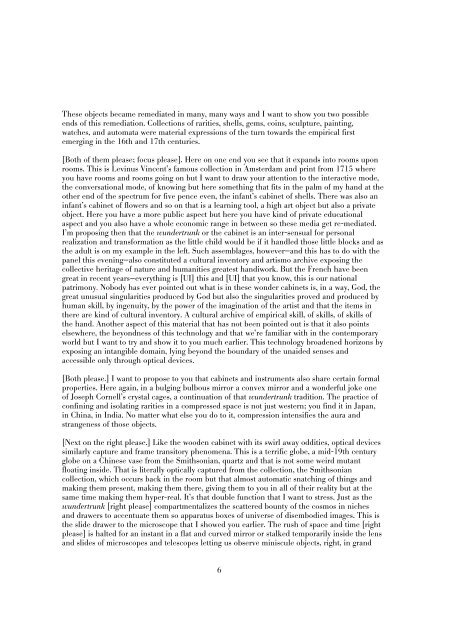SECTION 1 - via - School of Visual Arts
SECTION 1 - via - School of Visual Arts
SECTION 1 - via - School of Visual Arts
You also want an ePaper? Increase the reach of your titles
YUMPU automatically turns print PDFs into web optimized ePapers that Google loves.
These objects became remediated in many, many ways and I want to show you two possible<br />
ends <strong>of</strong> this remediation. Collections <strong>of</strong> rarities, shells, gems, coins, sculpture, painting,<br />
watches, and automata were material expressions <strong>of</strong> the turn towards the empirical first<br />
emerging in the 16th and 17th centuries.<br />
[Both <strong>of</strong> them please; focus please]. Here on one end you see that it expands into rooms upon<br />
rooms. This is Levinus Vincent’s famous collection in Amsterdam and print from 1715 where<br />
you have rooms and rooms going on but I want to draw your attention to the interactive mode,<br />
the conversational mode, <strong>of</strong> knowing but here something that fits in the palm <strong>of</strong> my hand at the<br />
other end <strong>of</strong> the spectrum for five pence even, the infant’s cabinet <strong>of</strong> shells. There was also an<br />
infant’s cabinet <strong>of</strong> flowers and so on that is a learning tool, a high art object but also a private<br />
object. Here you have a more public aspect but here you have kind <strong>of</strong> private educational<br />
aspect and you also have a whole economic range in between so these media get re-mediated.<br />
I’m proposing then that the wundertrunk or the cabinet is an inter-sensual for personal<br />
realization and transformation as the little child would be if it handled those little blocks and as<br />
the adult is on my example in the left. Such assemblages, however—and this has to do with the<br />
panel this evening—also constituted a cultural inventory and artismo archive exposing the<br />
collective heritage <strong>of</strong> nature and humanities greatest handiwork. But the French have been<br />
great in recent years—everything is [UI] this and [UI] that you know, this is our national<br />
patrimony. Nobody has ever pointed out what is in these wonder cabinets is, in a way, God, the<br />
great unusual singularities produced by God but also the singularities proved and produced by<br />
human skill, by ingenuity, by the power <strong>of</strong> the imagination <strong>of</strong> the artist and that the items in<br />
there are kind <strong>of</strong> cultural inventory. A cultural archive <strong>of</strong> empirical skill, <strong>of</strong> skills, <strong>of</strong> skills <strong>of</strong><br />
the hand. Another aspect <strong>of</strong> this material that has not been pointed out is that it also points<br />
elsewhere, the beyondness <strong>of</strong> this technology and that we’re familiar with in the contemporary<br />
world but I want to try and show it to you much earlier. This technology broadened horizons by<br />
exposing an intangible domain, lying beyond the boundary <strong>of</strong> the unaided senses and<br />
accessible only through optical devices.<br />
[Both please.] I want to propose to you that cabinets and instruments also share certain formal<br />
properties. Here again, in a bulging bulbous mirror a convex mirror and a wonderful joke one<br />
<strong>of</strong> Joseph Cornell’s crystal cages, a continuation <strong>of</strong> that wundertrunk tradition. The practice <strong>of</strong><br />
confining and isolating rarities in a compressed space is not just western; you find it in Japan,<br />
in China, in India. No matter what else you do to it, compression intensifies the aura and<br />
strangeness <strong>of</strong> those objects.<br />
[Next on the right please.] Like the wooden cabinet with its swirl away oddities, optical devices<br />
similarly capture and frame transitory phenomena. This is a terrific globe, a mid-19th century<br />
globe on a Chinese vase from the Smithsonian, quartz and that is not some weird mutant<br />
floating inside. That is literally optically captured from the collection, the Smithsonian<br />
collection, which occurs back in the room but that almost automatic snatching <strong>of</strong> things and<br />
making them present, making them there, giving them to you in all <strong>of</strong> their reality but at the<br />
same time making them hyper-real. It’s that double function that I want to stress. Just as the<br />
wundertrunk [right please] compartmentalizes the scattered bounty <strong>of</strong> the cosmos in niches<br />
and drawers to accentuate them so apparatus boxes <strong>of</strong> universe <strong>of</strong> disembodied images. This is<br />
the slide drawer to the microscope that I showed you earlier. The rush <strong>of</strong> space and time [right<br />
please] is halted for an instant in a flat and curved mirror or stalked temporarily inside the lens<br />
and slides <strong>of</strong> microscopes and telescopes letting us observe miniscule objects, right, in grand<br />
6








